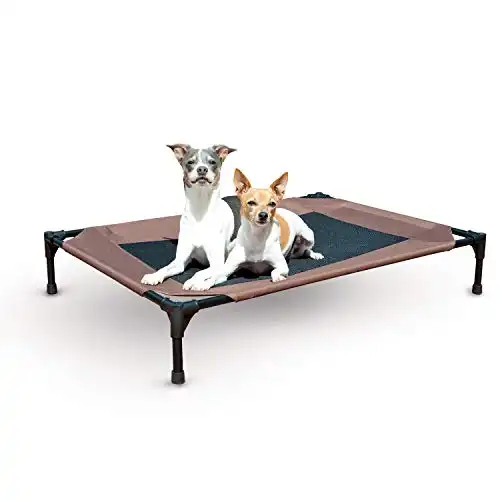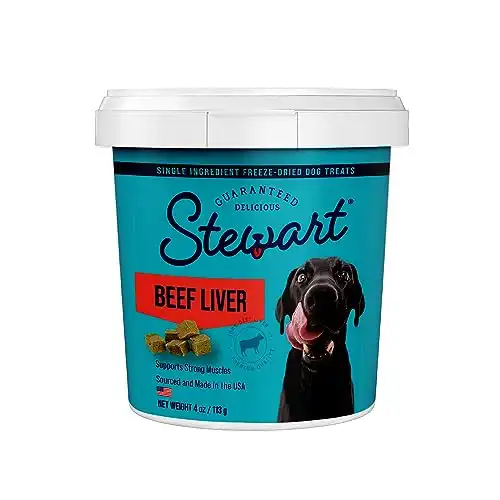Helping dogs have more fun with their humans!


For the first part of our series on creating agility equipment for your dog, we start with dog agility jumps! We will walk you through common behavioral issues & fixes, as well as how to make or buy different pieces of equipment. Whether you’re inside or outside, want to build your dog agility jumps, or purchase equipment, we have a solution for everyone.
As long as you’re healthy & encourage safe behavior, dog agility is a great way to bond with your pup and both have some activity. Even if you’re only doing it informally, like us, it’s a great way to keep your pup moving around. If you’re looking for a more in-depth explanation of some of the benefits of dog agility, check out our favorite resource for dog health, VCA Hospitals, and their Agility for Dogs post!
Dog agility jumps are one of the easiest equipment to rig up or create. In case you missed our first article, check out our guide on creating a DIY dog agility course for beginners! The guide has links to all our other resources on beginner dog agility equipment.
Learning the behavior
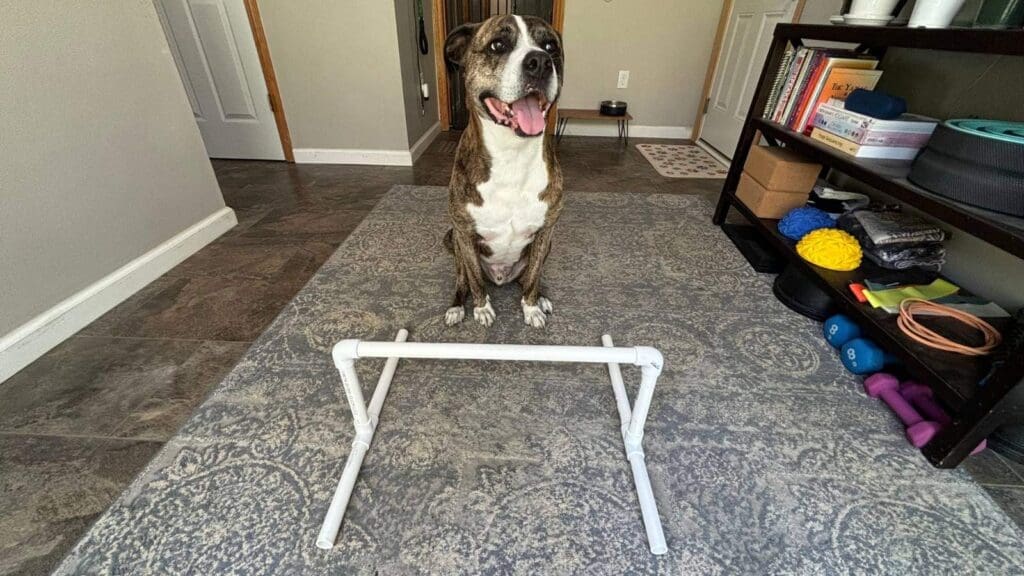

Learning the behavior required for dog agility jumps is generally easy for most pups. We need to persuade your pup to jump over a bar or similar object.
Most healthy pups are willing to complete this without difficulty, but if you have a pup who isn’t as willing on the first attempt, don’t worry! Check out our troubleshooting issues section and we’ll talk you through how to fix the two most common problems with dog agility jumps!
If you’re looking for a more structured approach to agility, check out our friends at Spirit Dog Training! We use their courses whenever we need a more structured approach to training. Here’s the curriculum for their Dog Agility @ Home course, if you want more information.
Some notes before getting started
Before you start trying dog agility jumps with your pup, let’s review some important information.
We recommend placing your jumps so that your dog can jump from and land on a rug or carpet instead of vinyl or tile to help keep your dog from slipping. Outside this is less of an issue, but try to stay away from any slick surfaces, uneven ground, or any other problem areas that would make it difficult to complete the behavior safely.
As always, proceed carefully before starting any physical activity with your dog. If you are not sure if your dog can perform an activity, consult a relevant professional, trainer, or vet. This guide is for educational purposes based on our own experiences and what works for our pups, not all pups.
With high-impact movements, it’s important to ensure your dog is healthy before any activity. One of the symptoms of an ACL tear in dogs is a reluctance to jump or put weight on their rear legs. Take this process slowly and give your pup plenty of rest between training sessions, especially at the beginning stages.
Teaching the behavior
Teaching your dog how to use dog agility jumps is easy, as long as you take it slow! We like Puppr’s method for learning new behavior and model most of our training similarly. It’s easy to remember, works, and the criteria are easy to follow! If your pup can perform the requested behavior 9 out of 10 times, they’re ready to advance the difficulty slightly.
To start, grab your dog agility jumps and set it up so that your dog can jump & land on a stable, non-slip surface. We recommend placing the bar so that your dog can walk over it without jumping initially to learn the behavior, similar to teaching how to use cavaletti to your dog.
Now, get your pup to go over the object you’re using a jump. Initially, this would be a walking movement and you can work up toward whatever height is safe for your dog. You can always increase the height later and there’s no need to have your pup jump over unsafe obstacles. The goal here is to have fun, so make sure to keep it that way for your dog!
We recommend using a lure to help during the training process & gradually decreasing how often you use it. One of our favorite treats to use as a lure is Stewart beef liver (Chewy)! Our pups go nuts for beef liver and it can be broken or cut into smaller pieces if you have a smaller pup. Check out our troubleshooting section for more help if you are still having issues.
That’s it! If you want to introduce a command like “over” or “jump” that’s fine! We recommend first waiting until your dog understands the behavior without a cue. This will help minimize confusion.
Some notes about safety
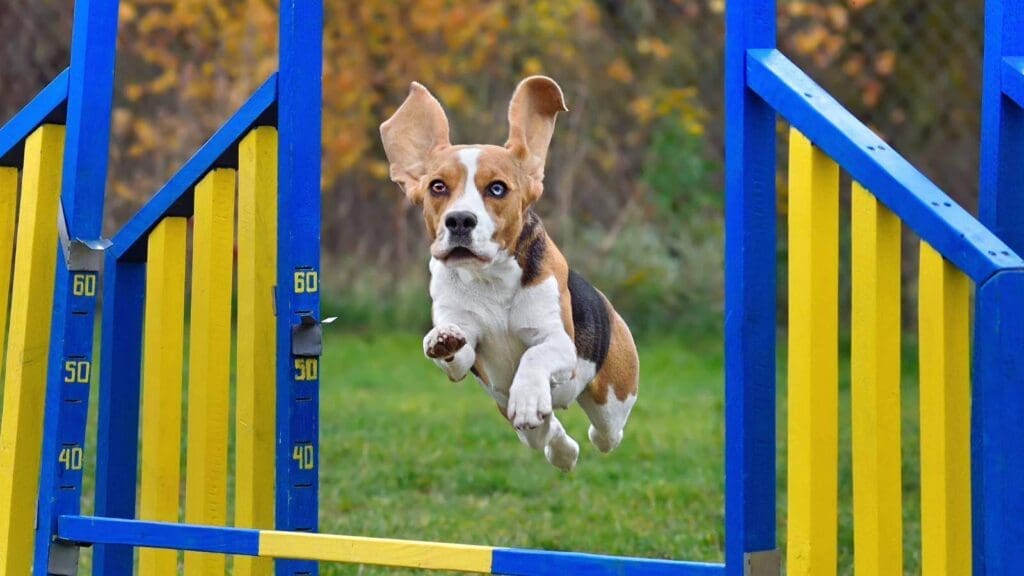

If your dog has a low activity level or isn’t used to jumping, we’d recommend taking higher-impact obstacles, like dog agility jumps, slower and in moderation. Your dog can and still have a great time learning the behavior without trying to jump heights that they aren’t conditioned to. Imagine how your muscles and joints would feel if you hadn’t run in years and tried to do hurdles. It is similar for your dog.
If your dog is visibly sore from performing any activity, give him rest for a few days and evaluate how he or she is doing at that point. Try out some less intense activities for a few days, such as DIY dog puzzles or frozen Kongs! The primary goal of beginner agility is to have fun, and we’re trying to avoid any negative associations or results from the activity. Take the training slowly and adjust your pace based on how your dog handles the activity.
Dog agility jumps can be one of your dog’s higher-impact obstacles, but is safe if you take it slow and let your dog tell you how they feel. If you have an older or mobility-impaired dog, you may not get much past walking over the bar and that’s fine! We’re here to have fun and bonus points aren’t given here for having the pup who can jump through over the highest bar.
If you want to try a lower-impact agility obstacle, check out our guides on dog agility tunnels or cavaletti for dogs! They’re a much better place to start for an older or less active dog than higher-impact obstacles like jumping or weaving.
Again, we recommend consulting with an expert (veterinarian, trainer, or other relevant professional) if you’re unsure of your dog’s ability to handle any new activity.
Equipment options for dog agility jumps
Now the part you’re here for, how to make dog agility jumps! We recommend trying the temporary options before building a DIY dog agility jump to make sure that you and your pup both enjoy the activity. It’s also typically a lot easier to change the height of the equipment with temporary configurations while your dog is learning the behavior.
Temporary options for dog training jumps
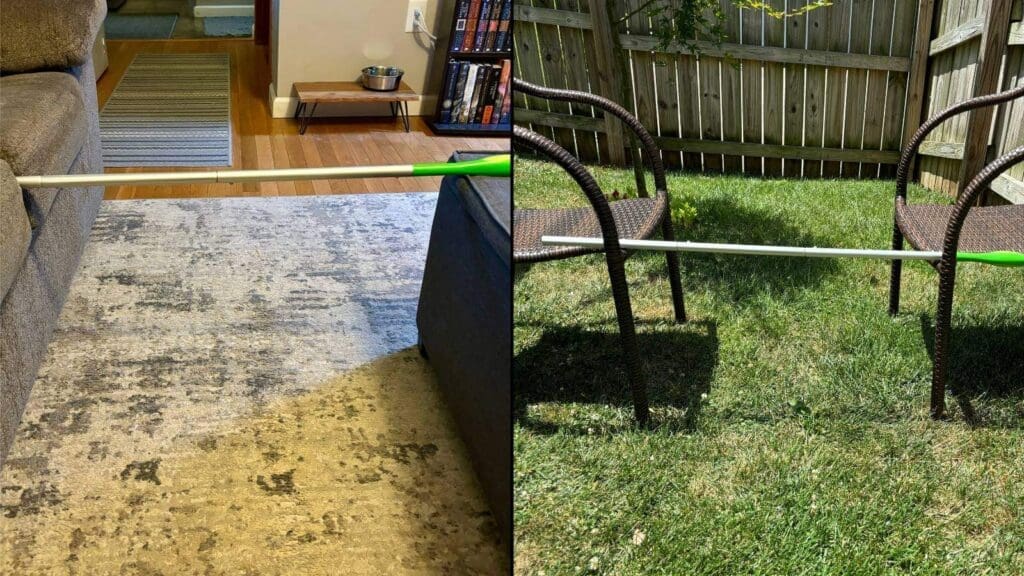

If you want to try a temporary solution for dog agility jumps before moving to anything more serious, you’re in luck! It’s one of the easiest pieces of agility equipment to rig up!
For inside options, any bar or pole-shaped item is perfect! Some of our favorites are brooms, dust mops, and driveway reflector poles, but anything light and similarly shaped is a great option. Cushions from furniture, dog crates, or workout equipment are good options to change the height of the bar, as your dog gets better at the behavior. We generally use a wire crate to brace one end of the bar and a nearby console table to support the other.
For outside dog agility jumps the options are a lot more open. Some of our favorite options are driveway reflector poles, PVC, pool noodles, or broom handles. We like PVC because it’s lightweight, cheap, and weather-resistant, but any of these options will work great! To adjust the height, a piece of lattice works great if you have that option. If you do not, buckets, outdoor furniture, or wire fence panels all can make great options!
Don’t be afraid to get creative with this, as it’s only a temporary solution.
Repurposing other equipment for dog jumps
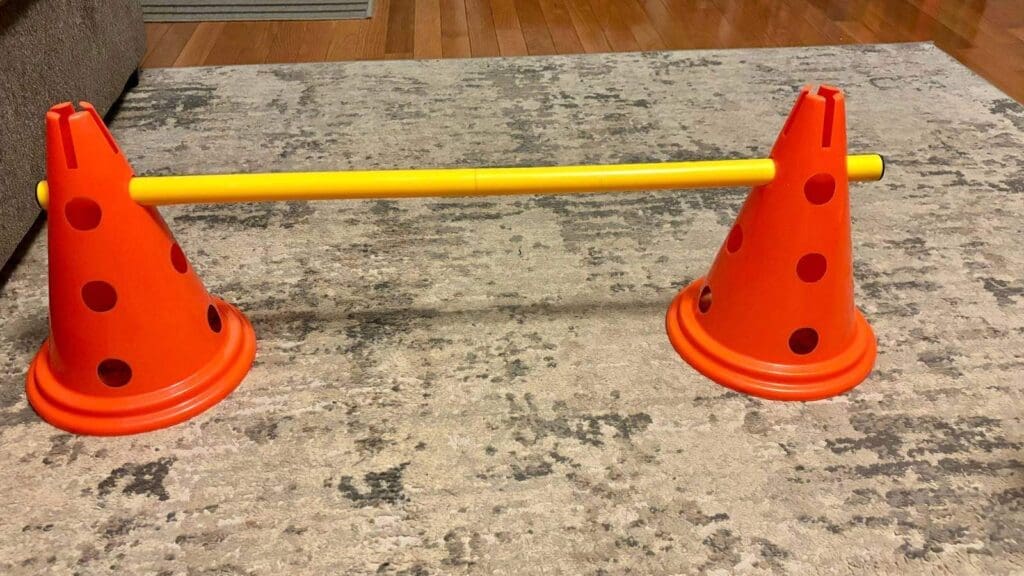

Our favorite option is to repurpose other equipment we have for dog agility jumps!
If you bought (or created) other dog equipment, there are a few different options that allow easy modifications to turn into dog agility jumps. If you happened to make the DIY option from our article on dog agility hoops, all you have to do is remove the top portion! That’s about as easy as it gets!
If you didn’t, we still have some other options! Our guide to cavaletti for dogs has a few different options we can repurpose! The velcro DIY option is great and extremely cheap.
Trixie's cavaletti set is our favorite, by far! We love that it's easily adjustable, lightweight, and works for small and large dogs. We've been doing cavaletti with Goomba for years as physical therapy and Trixie makes the movement simple!
- Easily adjustable
- Weather resistant
- Affordable
- Stores & moves easily
- Works for large & small dogs
- Can be knocked over if it's windy outside due to their light weight
We like the dog agility hurdle cone set the best though. It’s perfect for learning the behavior, affordable, and weatherproof! It comes with 3 different adjustable height options, perfect for learning the behavior. If you want to, you can place any of the items mentioned in the temporary section (buckets, furniture, etc) under the cones to adjust the height as high as you need to! We like that the Trixie cavaletti set (Amazon) stores well, too, which helps keep our garage from getting too cluttered with equipment.
How to make dog agility jumps


If you want to make your DIY dog agility jumps, we can do it for less than $15 and without any expensive tools! This will be similar to our DIY option for dog agility hoops, but even less work.
We’ll need some ½ or ¾-inch PVC tubing or similar material for materials. We went with ¾-inch PVC because that’s what we had on hand from a different project, but ½ is fine. Non-weight-bearing obstacles (like this one) are much more flexible with materials.
Here’s the supply list we used for our jump:
- 8 ft of PVC pipe
- 2 PVC 90-degree elbow fittings
- 2 PVC T fittings
- 4 PVC caps (optional, but recommended for waterproofing if you want to leave it outside)
We’ll also need the following tool:
- PVC cutting tool (if you don’t already have something else to cut PVC with)
We’ll walk you through what we made for our jump, but it’s easy to modify the dimensions if you have a larger or smaller dog. For reference, our dogs are relatively active and 80 lbs.
This DIY is fairly straightforward. You’ll only need two tools: a measuring tape and something to cut PVC with. We used a pipe-cutting tool, but any fine-toothed saw, oscillating tool, etc will be more than capable of dealing with PVC. We cut our PVC into 7 sections: 4×8 inch, 2×12 inch, and 1×20 inch.


First, we’ll make the legs of the jump. Connect 2×8-inch segments of PVC in a straight line with the T fitting. Place the 1×12-inch section so in the remaining opening. Repeat to create the second leg.
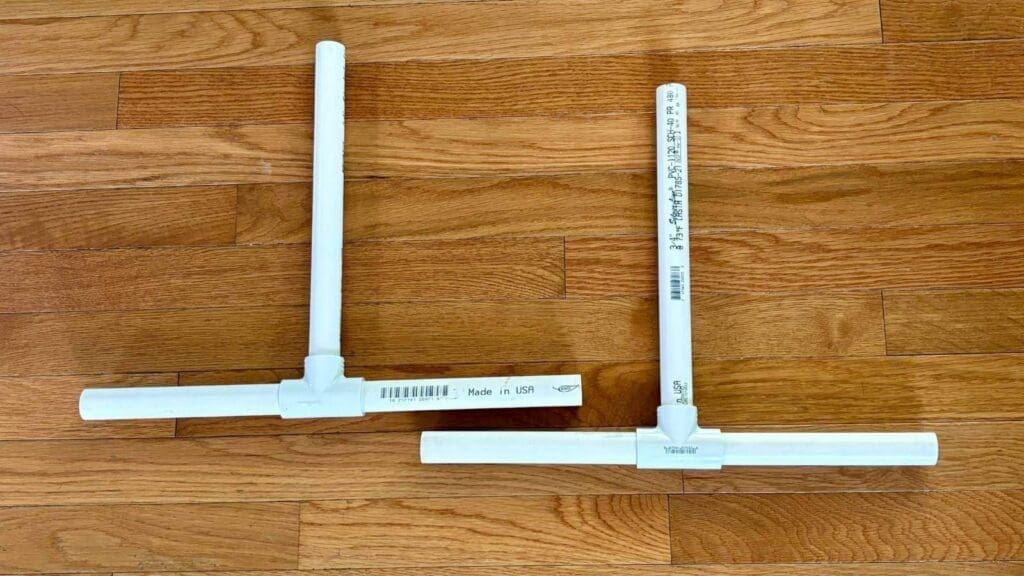

Next, take the 2 90-degree elbows and place them on top of the 12-inch sections of the legs. Connect the final piece of PVC (20-inch segment) between the elbows. That’s it!
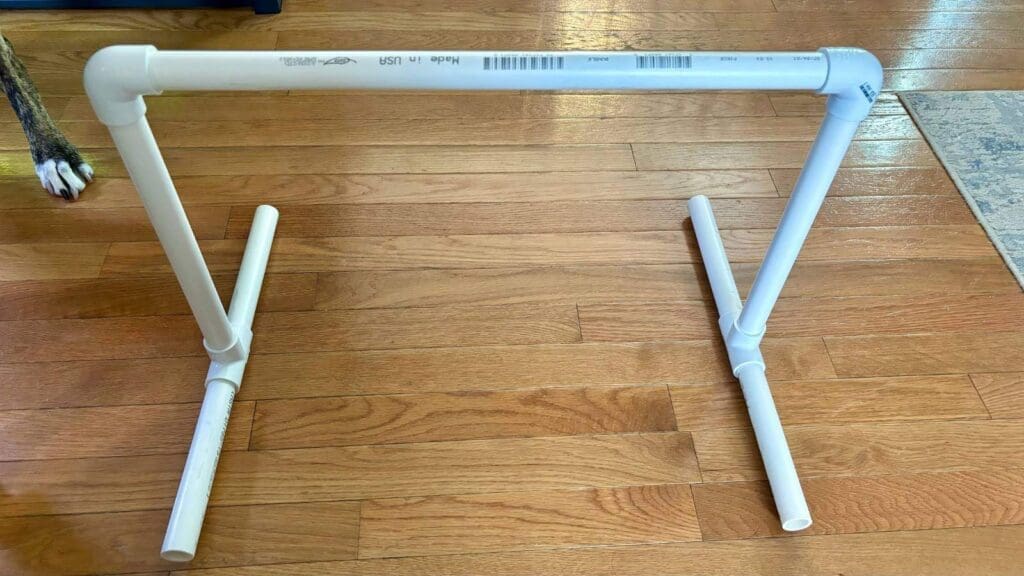

We like this design because you can swap out the 8-inch and 12-inch sections of PVC to get a slightly lower jump. This can provide some added flexibility while learning the behavior.
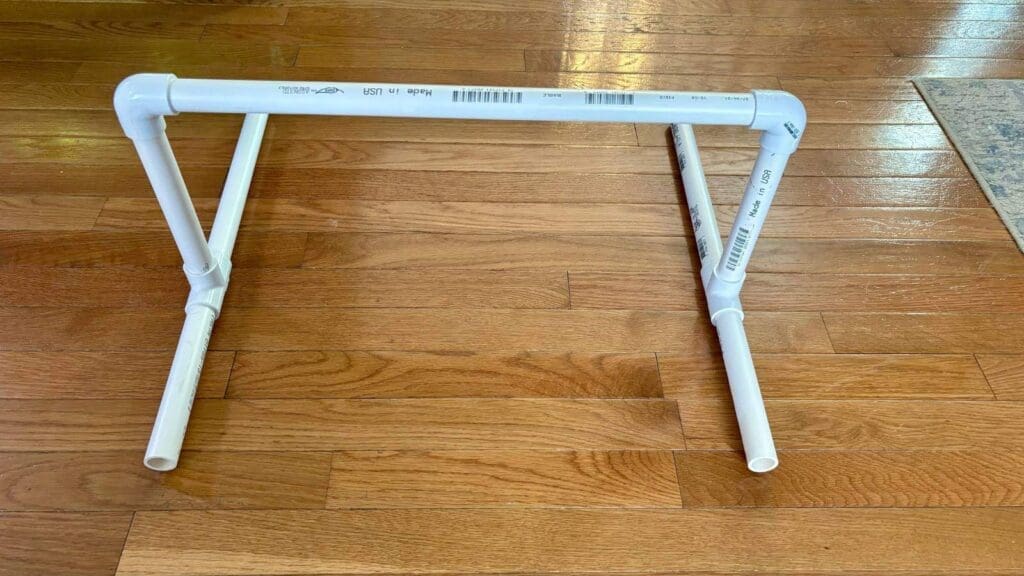

Looking back, if I were to do this again, I would change the length of the 4×8-inch pieces. I would make the legs different lengths to give a little more flexibility with the height. I’d probably do 2×8-inch pieces and 2×16-inch pieces, which would give you heights of 8, 12, and 16 inches on the same piece of equipment. It doesn’t really matter, but would give some more options, especially if you have a particularly tall dog.
Other notes & modifications
We wanted to add this section to provide some tips and tricks for making your (and your dog’s) life easier, especially while learning the behavior.
If you want to increase the height of your jump, we find it easy to use household objects to accomplish this. For example, any of the recommendations for support in the section temporary options for dog training jumps can be great ways to change the height of a jump. Some of our favorites are scrap wood, buckets, furniture, and workout equipment, but don’t be afraid to get creative!
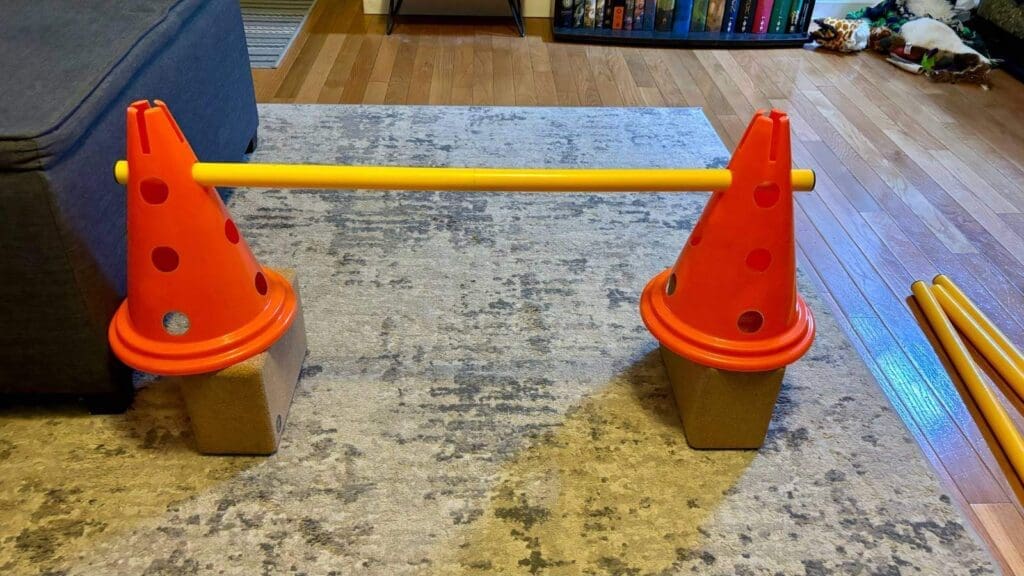

If you want to lower the height and your jump isn’t adjustable, use one of the temporary options until your pup gets the hang of it! If you made the DIY option, you can just pull out a section of PVC (in our example, the 12 in sections) and replace it with a shorter section that works better for you. We recommend not using PVC cement since this can give you a lot more flexibility.
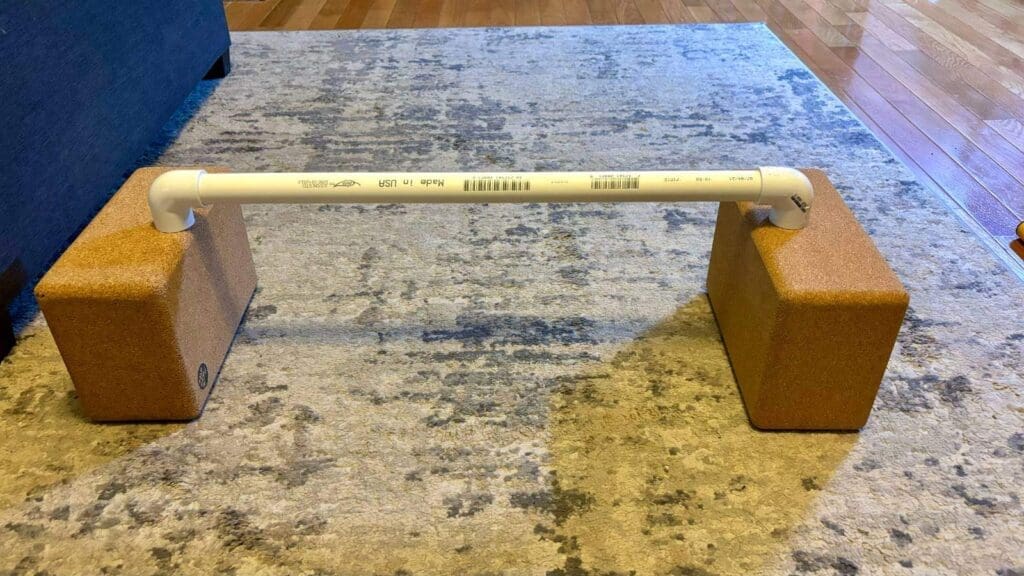

Finally, if you are averse to how PVC looks, don’t be afraid to use spray paint or a similar product on them! It doesn’t bother us, but it will look a lot cleaner and less like a DIY.
Troubleshooting common issues
If you’re having some issues teaching the behavior for dog agility jumps to your pup, you’re in the right place! We strongly recommend that you make sure your pup is healthy enough to jump, especially if they are hesitant to perform the behavior. The following troubleshooting will assume your pup has no underlying health issues that would affect their ability to perform the behavior.
Going around dog agility jumps
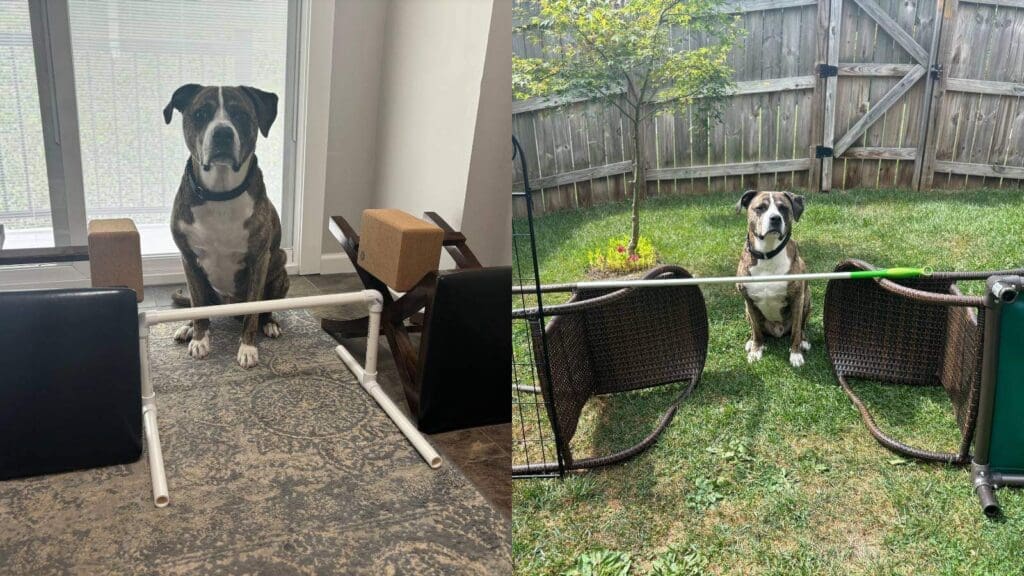

The most common issue that we’ve seen with dog agility jumps is that the dog tries to go under or around the equipment.
To help get our pups through this, we’ll be making it harder for them to fail with the behavior. We’ll be removing the wrong options so that it’ll be easier to perform the behavior correctly.
If your dog is crafty and tries to tunnel under the bar, block off the bottom section! Anything can work for this, but some of our favorites for indoor use are dog beds, blankets, and couch cushions. For outdoor use, we love using an elevated K&H dog bed, but if you’re looking for something else, outdoor furniture and cushions, plywood scraps, or a tarp can all work great!
This is Prim's favorite place and she's frequently outside basking in the sun on this elevated bed. We find the brown helps hide some of the inevitable mud that ends up on it. We love it since it's easy to clean & replace the cover if it gets ripped.
- Easy to clean
- Cheap & parts are replaceable
- Elevated & mesh features help keep your pup cooler
- Not the best option for large or heavy dogs
We can use a similar process for the sides, as well. If you’re starting inside, a hallway makes a fantastic spot to start. It’s much easier to block off due to already having sides. We prefer combining the hallway with couch cushions or dog beds to completely block off the sides. If that isn’t an option, you can use chairs, an elevated K&H dog bed, or any other items you have around.
Remember, these are intended as temporary guide rails for your pup until they understand the behavior better, so it doesn’t matter if they’re not visually appealing. Take it slow and your pup will understand the behavior in no time!
Not wanting to go over the jump
The second most common issue with teaching the behavior for dog agility jumps tends to be your dog refusing to jump over the bar. Fortunately, this is even easier to resolve than trying to avoid the jump.
To start, make sure that the bar is an appropriate height for your pup. If your pup is still having issues with not wanting to go over, lower the bar until they can walk over the jump. This is a great place to start and effectively turns the bar into a cavaletti set for dogs. If your pup continues to have issues, lower the bar to the floor and begin there. We can always raise the bar as they get more familiar with the behavior and more confident in their ability to go over the obstacle.
The second aspect is to make sure that you have a good enough lure to help your dog. As long as there isn’t any physical reason that your dog doesn’t want to perform the movement, the higher-value treat will help give your pup the extra motivation to go over most dog agility jumps. It helps if your pup has a high food drive, like our Prim. If your pup does not, training before feeding will help generate some extra motivation.
This is our (and our pups') favorite choice for beef liver! It's cheaper than a lot of other options and they go crazy for it! It's possible to cut it into smaller pieces to make it last longer.
Our favorite high-value treats are cheese, cooked chicken, or beef liver. We usually have cheese and cooked chicken available for dog treats, but beef liver is our preferred option for training. You can cut it to any size, it doesn’t need refrigeration, and it’s much less messy. If your dog has more of an interest in toys, grabbing their favorite toy will accomplish the same goal. We use toys for training with Goomba since he’s generally much more play-motivated.
We recommend combining both of these techniques initially to help give your dog the greatest chance of success.
Conclusion
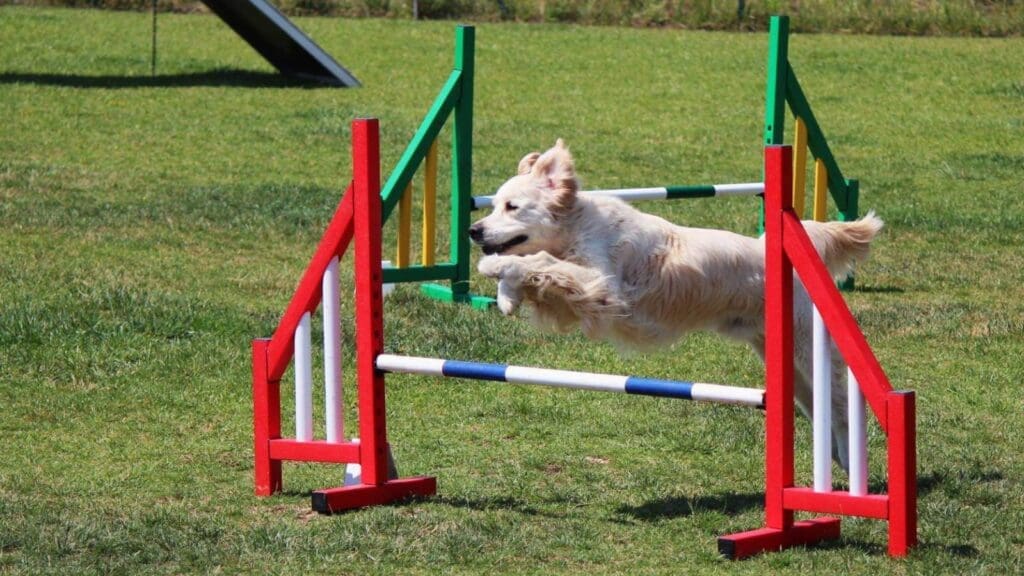

Teaching your pup how to use dog agility jumps can be an easy and rewarding experience for both you and your dog. We recommend trying the more temporary options first, to make sure that you and your dog enjoy the experience. Remember: the goal here is to have fun so take it slow and enjoy the experience!
We love to see your success with your dog agility jumps or any other type of agility equipment! Share photos of your dog trying out your dog agility hoop with us on Instagram by tagging @therulybully.
Have fun!

